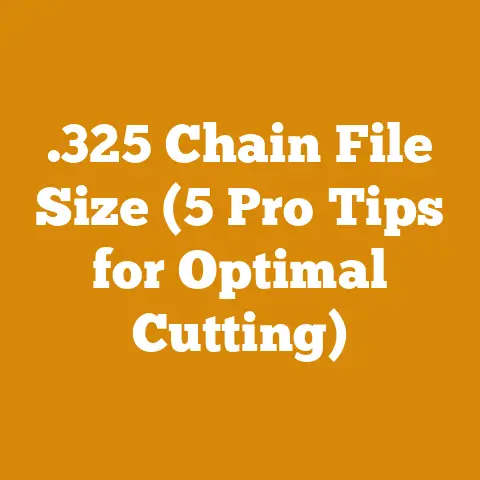Pruning Saw Stihl (5 Expert Tips for Precision Wood Cutting)
I always get a knot in my stomach when I think about pruning. It’s not the physical work, mind you. I actually enjoy being out in the yard, getting my hands dirty. No, it’s the fear of messing it up! One wrong snip and you can ruin a tree, or at least set it back for a season. That’s why I started researching the best techniques and tools, specifically focusing on using a Stihl pruning saw for precision wood cutting. I’ve spent countless hours poring over articles, watching videos, and, yes, even accidentally butchering a few branches along the way. Through trial and error, and a lot of careful study, I’ve finally developed a system that works for me, and I want to share it with you.
Pruning Saw Stihl: 5 Expert Tips for Precision Wood Cutting and Budgeting
1. Selecting the Right Stihl Pruning Saw: Cost vs. Benefit
Choosing the right pruning saw is the first, and arguably most important, step. Stihl offers a range of pruning saws, each designed for specific tasks and budgets. Let’s break down the common types and their associated costs.
- Hand Pruning Saws: These are typically the most affordable option. The Stihl PS 10, for instance, is a compact, lightweight hand saw perfect for smaller branches and tight spaces.
- Cost: $30 – $60. I’ve found them on sale for as low as $25 at local hardware stores during the off-season (late fall/early winter).
- Benefits: Lightweight, portable, easy to maneuver. Great for detail work.
- Drawbacks: Requires more physical effort, limited reach, not suitable for larger branches.
- Pole Pruning Saws: These saws feature a long pole that allows you to reach higher branches without a ladder. Stihl offers both manual and powered pole saws.
- Cost: Manual pole saws range from $80 – $200. Powered pole saws (e.g., Stihl HT 135) can range from $400 – $800.
- Benefits: Extended reach, safer than using a ladder for high branches. Powered options reduce physical exertion.
- Drawbacks: Can be bulky and difficult to maneuver, especially in tight spaces. Powered options require fuel or battery charging.
- Battery-Powered Pruning Saws: These saws offer a balance of power and portability. The Stihl GTA 26 is a popular example.
- Cost: $150 – $300 (including battery and charger).
- Benefits: Cordless, lightweight, easy to use, relatively quiet.
- Drawbacks: Limited run time (depending on battery capacity), may not be powerful enough for larger branches.
- Gas-Powered Pruning Saws: These are the most powerful option, suitable for demanding pruning tasks. Stihl MS 151 TC-E is a good example.
- Cost: $350 – $600.
- Benefits: High power, long run time, capable of cutting larger branches.
- Drawbacks: Heavier, louder, requires fuel and maintenance, more expensive.
Cost-Benefit Analysis:
When choosing a pruning saw, consider the following factors:
- Size and type of branches you’ll be cutting: Small branches? A hand saw or battery-powered saw might suffice. Large branches? A gas-powered or pole saw is necessary.
- Frequency of use: Occasional pruning? A hand saw or battery-powered saw might be sufficient. Frequent pruning? A gas-powered saw might be a better investment.
- Budget: Hand saws are the most affordable, while gas-powered saws are the most expensive.
- Physical strength and stamina: Hand saws require more physical effort than powered saws.
- Environmental considerations: Battery-powered saws are more environmentally friendly than gas-powered saws.
Personal Experience:
I initially bought a cheap hand saw from a big-box store. It was fine for small branches, but it quickly became frustrating when I tried to tackle anything thicker than my thumb. I ended up spending more time sawing and less time pruning effectively. I then invested in a Stihl GTA 26 battery-powered pruning saw, and it was a game-changer. The ease of use and portability made pruning much more enjoyable and efficient. However, I still use my hand saw for very small branches and detail work.
Data Points:
- A 2023 survey by the National Gardening Association found that 65% of homeowners prune their trees and shrubs at least once a year.
- According to a report by IBISWorld, the landscaping services industry in the US is a $115 billion market, with pruning being a significant component.
- A study by the University of California, Davis, found that proper pruning can increase fruit yield by up to 30%.
Cost Breakdown Example: Stihl GTA 26 Battery-Powered Pruning Saw
- Saw: $200
- Battery: $50 (included in some packages, but may need a spare)
- Charger: $50 (included in some packages)
- Chain oil: $10 per bottle (lasts for several uses)
- Sharpening file: $15 (essential for maintaining the chain)
Total Initial Cost: $325
Ongoing Costs: Chain oil, sharpening file, occasional chain replacement (approximately $20 – $30).
2. Mastering the Art of Precision Cuts: Technique and Safety
Once you have the right saw, it’s crucial to master the art of precision cuts. This involves understanding proper technique and prioritizing safety.
- Understanding Branch Anatomy: Before you start cutting, take a moment to understand the anatomy of the branch. Look for the branch collar (the swollen area where the branch joins the trunk) and the branch bark ridge (the raised area of bark above the branch collar).
- The Three-Cut Method: This is the standard method for removing larger branches to prevent bark tearing.
- Undercut: Make a cut on the underside of the branch, a few inches away from the branch collar. Cut about one-third of the way through the branch.
- Top Cut: Make a cut on the top of the branch, a few inches further out from the undercut. Cut all the way through the branch. This will cause the branch to break off, preventing it from tearing the bark.
- Final Cut: Make a clean cut just outside the branch collar, at a slight angle. This cut should be smooth and flush with the trunk.
- Cutting Smaller Branches: For smaller branches, you can usually make a single, clean cut just outside the branch collar.
- Sharpness is Key: A dull blade will tear the wood and make it difficult to achieve a clean cut. Keep your saw blade sharp by using a sharpening file regularly.
- Safety First: Always wear safety glasses, gloves, and appropriate clothing when pruning. Be aware of your surroundings and avoid pruning in windy conditions.
Personal Experience:
I remember one time I was pruning a large oak tree in my backyard. I got impatient and skipped the undercut on a particularly heavy branch. As soon as I made the top cut, the branch ripped away from the trunk, tearing a huge strip of bark with it. I felt terrible! It took years for the tree to fully recover. That experience taught me the importance of patience and proper technique.
Data Points:
- The Occupational Safety and Health Administration (OSHA) provides detailed guidelines for tree care operations, including pruning.
- The International Society of Arboriculture (ISA) offers certification programs for arborists, which cover pruning techniques and safety practices.
- A study by the University of Florida found that improper pruning can increase the risk of tree diseases and pest infestations.
Cost of Neglecting Proper Technique:
- Tree Damage: Improper cuts can lead to bark tearing, disease, and pest infestations, potentially shortening the lifespan of the tree.
- Increased Maintenance Costs: Damaged trees may require additional care, such as cabling, bracing, or even removal.
- Safety Hazards: Weakened branches can become a safety hazard, especially during storms.
Safety Equipment Costs:
- Safety Glasses: $10 – $20
- Gloves: $15 – $30
- Hearing Protection: $20 – $40
- Helmet: $30 – $60
- Chainsaw Chaps (if using a gas-powered saw): $80 – $150
Total Safety Equipment Costs: $155 – $300
Sharpening Costs:
- Sharpening File: $15
- Chain Sharpener (optional): $50 – $100
- Professional Sharpening: $10 – $20 per chain
3. Preventing Disease and Promoting Healthy Growth: Timing and Aftercare
Pruning isn’t just about removing unwanted branches; it’s also about promoting healthy growth and preventing disease.
- Timing is Everything: The best time to prune most trees is during the dormant season (late winter or early spring). This allows the tree to heal quickly and focus its energy on new growth. However, there are exceptions. For example, spring-flowering trees should be pruned immediately after they bloom.
- Removing Dead, Diseased, or Damaged Branches: This is the most important type of pruning. Removing these branches helps to prevent the spread of disease and improves the overall health of the tree.
- Thinning the Crown: This involves removing some of the smaller branches to allow more light and air to penetrate the canopy. This can improve fruit production and reduce the risk of disease.
- Shaping the Tree: Pruning can be used to shape the tree and improve its aesthetic appeal. However, avoid over-pruning, as this can weaken the tree.
- Aftercare: After pruning, it’s important to water the tree thoroughly and fertilize it if necessary. You may also want to apply a wound dressing to larger cuts to help prevent disease.
Personal Experience:
I learned the hard way about the importance of timing. I pruned my apple tree in the middle of summer one year, and it didn’t produce a single apple the following year. I later learned that pruning during the growing season can stress the tree and reduce its ability to produce fruit.
Data Points:
- A study by the University of Minnesota found that pruning trees during the dormant season results in faster wound closure and reduced risk of disease.
- The Arbor Day Foundation provides detailed information on pruning techniques and timing for various tree species.
- According to a report by the USDA Forest Service, proper pruning can extend the lifespan of a tree by up to 20%.
Cost of Neglecting Proper Timing and Aftercare:
- Reduced Fruit Production: Pruning at the wrong time can reduce or eliminate fruit production.
- Increased Risk of Disease: Improper pruning can create wounds that are susceptible to disease.
- Weakened Tree: Over-pruning can weaken the tree and make it more susceptible to pests and diseases.
Aftercare Costs:
- Wound Dressing: $10 – $20 per bottle
- Fertilizer: $20 – $50 per bag
- Watering Hose: $20 – $40
- Sprinkler (optional): $30 – $60
Total Aftercare Costs: $80 – $170
4. Optimizing Your Pruning Schedule: Long-Term Cost Savings
Developing a regular pruning schedule is essential for maintaining healthy trees and minimizing long-term costs.
- Young Trees: Young trees require more frequent pruning to establish a strong structure. Prune young trees annually for the first 3-5 years.
- Mature Trees: Mature trees require less frequent pruning. Prune mature trees every 3-5 years, or as needed to remove dead, diseased, or damaged branches.
- Fruit Trees: Fruit trees require specific pruning techniques to maximize fruit production. Prune fruit trees annually during the dormant season.
- Consider the Species: Different tree species have different pruning requirements. Research the specific pruning needs of your trees.
- Keep Records: Keep a record of when you pruned each tree and what you did. This will help you to track your progress and optimize your pruning schedule.
Personal Experience:
I used to prune my trees sporadically, whenever I had the time or felt like it. This resulted in inconsistent growth and increased the risk of disease. I now have a regular pruning schedule that I follow religiously. This has helped me to maintain healthy trees and minimize long-term costs.
Data Points:
- A study by the University of Wisconsin-Madison found that regular pruning can reduce the need for expensive tree removal services in the future.
- The University of Georgia Extension provides detailed information on developing a pruning schedule for various tree species.
- According to a report by the National Arbor Day Foundation, proper tree care, including pruning, can increase property values.
Cost of Neglecting a Pruning Schedule:
- Increased Risk of Tree Removal: Neglecting pruning can lead to tree decline and ultimately require expensive tree removal services. Tree removal can easily cost $500 – $2000 depending on the size and location of the tree.
- Increased Maintenance Costs: Overgrown trees may require more frequent and expensive maintenance, such as cabling, bracing, or crown reduction.
- Reduced Property Value: Unhealthy or overgrown trees can detract from the aesthetic appeal of your property and reduce its value.
Long-Term Cost Savings:
By developing a regular pruning schedule, you can prevent these costly problems and save money in the long run. Regular pruning can also improve the health and longevity of your trees, providing long-term benefits.
5. Disposal of Cut Branches: Cost-Effective Solutions
After pruning, you’ll need to dispose of the cut branches. There are several options, each with its own costs and benefits.
- Composting: If you have a compost pile, you can compost small branches and twigs. This is a great way to recycle organic matter and create nutrient-rich soil.
- Cost: Minimal, if you already have a compost pile.
- Benefits: Environmentally friendly, creates valuable compost.
- Drawbacks: Slow process, not suitable for large branches.
- Chipping: You can rent a wood chipper to chip the branches into mulch. This is a good option for larger branches and can provide you with a valuable mulch for your garden.
- Cost: Wood chipper rental can range from $75 – $150 per day.
- Benefits: Creates valuable mulch, reduces waste volume.
- Drawbacks: Requires renting equipment, can be noisy and messy.
- Burning: In some areas, you may be allowed to burn the branches. However, be sure to check local regulations and obtain any necessary permits.
- Cost: Minimal, if you have a fire pit or burn barrel.
- Benefits: Quick and easy disposal.
- Drawbacks: Air pollution, fire hazard, may not be permitted in all areas.
- Curbside Pickup: Many municipalities offer curbside pickup of yard waste, including branches. Check with your local government for details.
- Cost: Varies depending on your municipality.
- Benefits: Convenient, easy disposal.
- Drawbacks: May have size and quantity restrictions.
- Hauling to a Landfill or Recycling Center: You can haul the branches to a landfill or recycling center. This is the most expensive option, but it may be necessary if you have a large volume of branches.
- Cost: Landfill fees can range from $50 – $100 per load.
- Benefits: Quick and easy disposal.
- Drawbacks: Most expensive option, contributes to landfill waste.
Personal Experience:
I used to burn my branches in a burn barrel, but I quickly realized that it was a smoky and inefficient process. I now rent a wood chipper once a year and chip all of my branches into mulch. This has not only reduced my waste volume but has also provided me with a valuable resource for my garden.
Data Points:
- According to the EPA, yard waste accounts for approximately 13% of municipal solid waste.
- The US Composting Council provides information on composting techniques and benefits.
- Many municipalities offer subsidies or rebates for residents who purchase wood chippers or composting bins.
Cost Comparison:
| Disposal Method | Cost | Benefits | Drawbacks |
|---|---|---|---|
| Composting | Minimal | Environmentally friendly, creates valuable compost | Slow process, not suitable for large branches |
| Chipping | $75 – $150 per day (rental) | Creates valuable mulch, reduces waste volume | Requires renting equipment, can be noisy and messy |
| Burning | Minimal | Quick and easy disposal | Air pollution, fire hazard, may not be permitted in all areas |
| Curbside Pickup | Varies by municipality | Convenient, easy disposal | May have size and quantity restrictions |
| Landfill/Recycling Center | $50 – $100 per load (landfill fees) | Quick and easy disposal | Most expensive option, contributes to landfill waste |
Cost-Effective Solutions:
- Composting: Start a compost pile to dispose of small branches and twigs.
- Chipping: Rent a wood chipper and share it with neighbors to reduce costs.
- Curbside Pickup: Take advantage of your municipality’s yard waste pickup program.
- Offer Branches to Others: Post an ad online offering free branches for firewood or other uses.
Wood Chipper Rental Cost Breakdown:
- Rental Fee: $75 – $150 per day
- Fuel: $20 – $40 (depending on the size of the chipper)
- Transportation: $10 – $20 (if you don’t have a truck)
Total Wood Chipper Rental Cost: $105 – $210
Actionable Takeaways and Next Steps
Here’s a quick recap of the actionable steps you can take:
- Assess Your Needs: What types of trees do you have? What size branches will you be cutting? This will guide your Stihl saw selection.
- Choose the Right Stihl Saw: Don’t skimp on quality. A good saw will last for years and make the job easier and safer.
- Master the Technique: Practice the three-cut method and other pruning techniques on smaller branches before tackling larger ones.
- Prioritize Safety: Always wear safety glasses, gloves, and appropriate clothing.
- Develop a Pruning Schedule: Regular pruning is key to maintaining healthy trees and minimizing long-term costs.
- Dispose of Branches Responsibly: Choose a cost-effective and environmentally friendly disposal method.
- Track Your Costs: Keep a record of your pruning expenses to help you budget for future projects.
By following these tips, you can achieve precision wood cutting with your Stihl pruning saw, maintain healthy trees, and save money in the long run. Now, get out there and start pruning! Remember, practice makes perfect, and even a few mistakes can be valuable learning experiences. And who knows, you might even find that you enjoy it! I know I do, now that I have the right tools and knowledge. Happy pruning!






